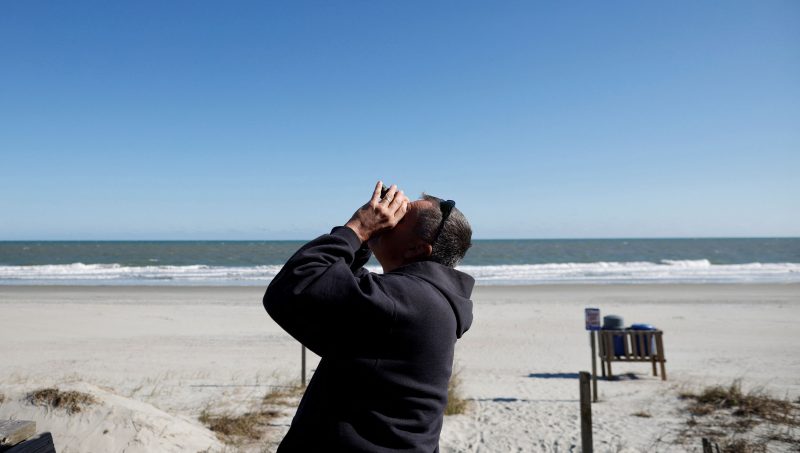When Scott Comey, a real estate broker in Myrtle Beach, S.C., got cellphone video from his backyard of the moment an F-22 fighter jet missile blasted the Chinese spy balloon, he raced to post it to his social media platform of choice: the Chinese-owned video app TikTok.
The world’s most popular app, used by roughly 100 million in the United States, has been constantly criticized in Washington as a platform that the Chinese government could use to shape and censor what Americans see.
But Comey’s video capturing one of China’s most embarrassing geopolitical blunders wasn’t suppressed. To his delight, the video was viewed more than 2.3 million times in two days — especially impressive given Comey only has 3,000 followers. The views came largely thanks to TikTok’s algorithmic boost.
“My wife and I were watching that video’s views go up as the minutes went by. We hit a million in an hour and 20 minutes,” Comey told The Post. Many commenters, he said, were excited to watch the global squabble play out in real-time on their phones. “I bet the pilot who got to shoot that was stoked!” one commenter said.
TikTok’s critics have argued that the spy balloon should serve as a reminder of the threat posed by China’s surveillance and propaganda work. Rep. Matt Gaetz (R-Fla.) tweeted Sunday that “TikTok is a bigger threat than the Balloon” and urged the Biden administration to “blow up” TikTok next.
“The real Chinese spy balloon is called TikTok,” one Baptist pastor in Georgia tweeted, “and your kids are on it 4 to 6 hours every day.”
But many of the most popular TikTok videos around the episode haven’t looked like Chinese propaganda at all. They’ve come from authoritative U.S.-based news channels. They’ve poked fun at the Chinese government. And, in some cases, they’ve featured loud, proud American patriots.
One video posted by user “bubbathompson0” in South Carolina, captioned “When your drunk buddy gets a video shooting the Chinese balloon down,” includes two men gleefully offering play-by-play commentary of the balloon getting zapped out of the sky. “He threw a missile at it! … F— you Commie China! … hell yeah!”
That video received at least 1.7 million views and has been ‘liked’ 135,000 times, a level of engagement that suggests TikTok promoted it widely. The poster’s most recent video before that, of a dachshund enjoying the breeze, had about 3,000 views.
TikTok’s opaque recommendation algorithm, like those of its American social media competitors, makes it hard for outsiders to know exactly which videos are being surfaced or ignored. And TikTok’s critics have said that should fuel suspicion that ByteDance — TikTok’s parent company, founded in Beijing — could work to sink videos critical of China and elevate ones extolling the ruling Communist Party’s ideals.
But the spy balloon suggests a more nuanced situation: that of a colorful, chaotic social network containing many views of the same events, hewing to no clear political dogma and reflecting the creativity and sensibilities of a vast and raucous user base.
The internet inside China is infamously censored, but TikTok has long professed that the Chinese government has no influence over content outside its borders. Though TikTok has apologized for some takedowns it says were mistakes, the app offers anyone who searches for it a long stream of video content that would otherwise be banned in China, from discussion of the country’s historical crimes to modern-day human-rights abuses.
It’s hard to imagine a TikTok closely controlled by Chinese censors, for instance, sending 5 million viewers to watch an otherwise unremarkable 5-second TikTok video of someone giving the Chinese balloon two upraised middle fingers.
Or allowing hashtags like #chinesespyballoon to surpass 90 million views, given that the Chinese government has fiercely disputed that characterization, saying the “airship” was merely a weather balloon that “strayed into the United States by mistake.”
TikTok is one of the country’s fastest-growing sources of online information, and a third of America’s TikTok users told Pew Research Center they use it to get the news. From the balloon’s slow float over Montana to the explosion-debris retrieval by military boat, many commenters said they were excited to track the episode on a video platform that felt “faster than the news.”
Others just saw it as a great punchline. Patrick Cloyd, whose company Freedom Balloon Rides runs hot-air balloon tours from Indianola, Iowa, posted a video from a recent flight, captioned it “POV: Casually flying over Missouri and start to see fighter jets circling your balloon,” and spliced in a short movie freakout scene.
“I was just sitting on my couch thinking, ‘I should make some video about this Chinese balloon. The iron’s pretty hot right now,’” he said. It’s been viewed more than 500,000 times.
Some videos’ comments sections descended into political fighting or conspiracy theories, a common endpoint of modern social media debate on Facebook, Twitter and other American social media sites.
TikTok’s openness to real-world storylines the Chinese government would prefer people forget doesn’t resolve the other points of TikTok criticism, including questions over how the company will protect people’s data from government spying or misuse.
But to people like Comey, the real estate broker in Myrtle Beach, the outrage over TikTok’s roots feels “a little overstated.” Because his friends and family aren’t frequent TikTok users, he sees the app as his “personal fun social media,” a place where memes and jokes and pranks are more common than the online political spats he can find anywhere else.
He was walking home with his wife from a friend’s place on Saturday when they spotted the balloon, and he decided to sit out on his patio recording it while his wife went inside to watch the TV for updates. When he saw the balloon explode, he posted the video within a minute to TikTok and nowhere else. “I wasn’t trying to beat the news,” he said. “I was just like, ‘I’ve gotta send this to TikTok.’”
He said it’s hard to know the whole story about what the Chinese government does with TikTok, though he’s leery of the claim that it’s their big secret spy device. “What would they be seeing, anyway?” he said.
Whatever the truth, he’s having fun. The day after his video went viral, he posted another TikTok of seemingly lower international importance: his friend messing up during a bowling game. It got 441 views.



























